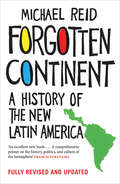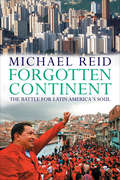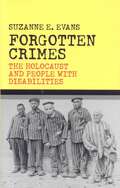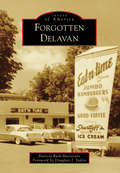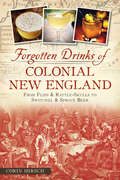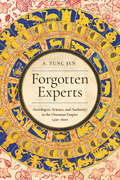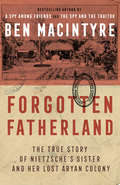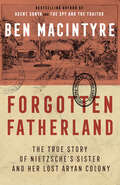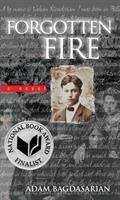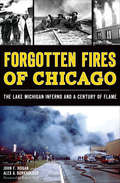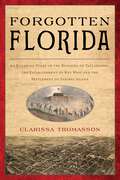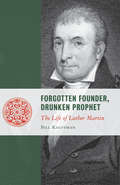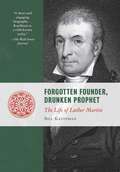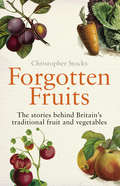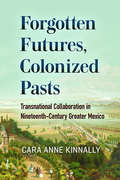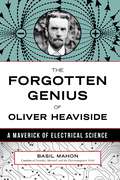- Table View
- List View
Forgotten Columbus (Images of America)
by Andrew HendersonColumbus, Ohio, "an odd amalgam of the planned and the spontaneous," was founded on the banks of the Scioto River in 1812 as the new seat of this young state's government. Located in the wilderness of central Ohio, nearly equidistant to the "real" cities of Cincinnati, Cleveland, and Toledo, Columbus experienced 100 years of unprecedented growth from which it would emerge the state's capital in more than title alone. Today, it is Ohio's largest city. Forgotten Columbus features many people, places, and events that defined this burgeoning 19th and early-20th century city. And above all, the places--from the Old Ohio Penitentiary, to Fort Hayes, to the recently revitalized Brewery District--which either no longer exist, or have changed so dramatically over the years that they are barely recognizable. Residents and visitors alike will find this a fascinating, insightful, and at times surprising look back at a forgotten era in Columbus's history.
Forgotten Continent: A History of the New Latin America
by Michael ReidThe bestselling primer on the social, political, and economic challenges facing Central and South America—now fully revised and updated. Ten years after its first publication, Michael Reid&’s bestselling survey of the state of contemporary Latin America has been wholly updated to reflect the new realities of the &“Forgotten Continent.&” The former Americas editor for the Economist, Reid suggests that much of Central and South America, though less poor, less unequal, and better educated than before, faces harder economic times now that the commodities boom of the 2000s is over. His revised, in-depth account of the region reveals dynamic societies more concerned about corruption and climate change, the uncertainties of a Donald Trump-led United States, and a political cycle that, in many cases, is turning from left-wing populism to center-right governments. This essential new edition provides important insights into the sweeping changes that have occurred in Latin America in recent years and indicates priorities for the future. &“[A] comprehensive and erudite assessment of the region . . . While the social and economic face of Latin America is becoming more attractive, political life remains ugly and, in some countries, is getting even uglier.&”—The Washington Post &“Excellent . . . a comprehensive primer on the history, politics, and culture of the hemisphere.&”—Francis Fukuyama, New York Times bestselling author &“Reid&’s book offers something valuable to both specialists and the general reading public . . . He writes of Latin America with great empathy, intelligence, and insight.&”—Hispanic American Historical Review
Forgotten Continent: The Battle For Latin America's Soul
by Michael ReidThe bestselling primer on the social, political, and economic challenges facing Central and South America by The Economist editor and author of Brazil. Latin America has often been condemned to failure. Neither poor enough to evoke Africa&’s moral crusade, nor as explosively booming as India and China, it has largely been overlooked by the West. Yet this vast continent, home to half a billion people, the world&’s largest reserves of arable land, and 8.5 percent of global oil, is busily transforming its political and economic landscape. This book argues that rather than failing the test, Latin America&’s efforts to build fairer and more prosperous societies make it one of the world&’s most vigorous laboratories for capitalist democracy. In many countries—including Brazil, Chile and Mexico—democratic leaders are laying the foundations for faster economic growth and more inclusive politics, as well as tackling deep-rooted problems of poverty, inequality, and social injustice. They face a new challenge from Hugo Chávez&’s oil-fueled populism, and much is at stake. Failure will increase the flow of drugs and illegal immigrants to the United States and Europe, jeopardize stability in a region rich in oil and other strategic commodities, and threaten some of the world&’s most majestic natural environments. Drawing on Michael Reid&’s many years of reporting from inside Latin America&’s cities, presidential palaces, and shantytowns, the book provides a vivid, immediate, and informed account of a dynamic continent and its struggle to compete in a globalized world. &“No one who seriously aspires to discuss Latin American politics, economics, and culture should go without reading Forgotten Continent.&”—National Interest
Forgotten Crimes: The Holocaust And People With Disabilities
by Suzanne E. EvansBetween 1939 and 1945 the Nazi regime systematically murdered hundreds of thousands of children and adults with disabilities as part of its "euthanasia" programs. These programs were designed to eliminate all persons with disabilities who, according to Nazi ideology, threatened the health and purity of the German race. Forgotten Crimes explores the development and workings of this nightmarish process, a relatively neglected aspect of the Holocaust. Suzanne Evans's account draws on the rich historical record as well as scores of exclusive interviews with disabled Holocaust survivors. It begins with a description of the Nazis' Children's Killing Program, in which tens of thousands of children with mental and physical disabilities were murdered by their physicians, usually by starvation or lethal injection. The book goes on to recount the T4 euthanasia program, in which adults with disabilities were disposed of in six official centers, and the development of the Sterilization Law that allowed the forced sterilization of at least a half-million young adults with disabilities. Ms. Evans provides portraits of the perpetrators and accomplices of the killing programs, and investigates the curious role of Switzerland's rarely discussed exclusionary immigration and racially eugenic policies. Finally, Forgotten Crimes notes the inescapable implications of these Nazi medical practices for our present-day controversies over eugenics, euthanasia, genetic engineering, medical experimentation, and rationed health care.
Forgotten Delavan
by Douglass J. Yadon Patricia Ruth-MarsicanoWhen they left New York in 1836, brothers Henry and Samuel Phoenix intended to establish a temperance colony where inhabitants could live a life free from "demon alcohol." They found the perfect location in the Wisconsin Territory and named it Delavan after temperance leader and abolitionist Edward C. Delavan. The Phoenixes purchased 400 acres of land to sell to friends and family back in New York. The population soon boomed thanks to people like themselves who embraced the belief in an alcohol- and slavery-free society. All deeds were written with covenants prohibiting alcohol, but in 1845 the covenants were deemed unconstitutional. Since then, Delavan has been home to abolitionists, circus performers, and artists. It has drawn tourists from around the Midwest to its ballrooms, resorts, steamers, and beautiful lake. From Delavan's humble beginnings, the community has continued to grow to a population of more than 13,000, and today Delavan thrives on its industry, agriculture, and tourism.
Forgotten Detroit (Images of America)
by Paul VachonDetroiters know their history well. Founded in 1701 by Antoine de la Mothe Cadillac, the city subsisted on a variety of industries: fur trading, stove building, and, of course, the automobile. Names such as Henry Ford and Charles Lindbergh resonate in Detroiters' common memory. Detroit's meteoric rise during the 20th century established the city as an influential leader in commerce, culture, and religion. This growth spawned the development of numerous businesses, organizations, and institutions, many now forgotten. Albert Kahn left his indelible mark. Mary Chase Stratton created a new art form. And Henry Ford II changed the course of his family legacy. Forgotten Detroit delves into the wellspring of history to retell some of these lesser-known stories within Detroit's rich heritage.
Forgotten Disease: Illnesses Transformed in Chinese Medicine (Studies Of The Weatherhead East Asian Institute, Columbia University Ser.)
by Hilary A. SmithAround the turn of the twentieth century, disorders that Chinese physicians had been writing about for over a millennium acquired new identities in Western medicine—sudden turmoil became cholera; flowers of heaven became smallpox; and foot qi became beriberi. Historians have tended to present these new identities as revelations, overlooking evidence that challenges Western ideas about these conditions. In Forgotten Disease, Hilary A. Smith argues that, by privileging nineteenth century sources, we misrepresent what traditional Chinese doctors were seeing and doing, therefore unfairly viewing their medicine as inferior. Drawing on a wide array of sources, ranging from early Chinese classics to modern scientific research, Smith traces the history of one representative case, foot qi, from the fourth century to the present day. She examines the shifting meanings of disease over time, showing that each transformation reflects the social, political, intellectual, and economic environment. The breathtaking scope of this story offers insights into the world of early Chinese doctors and how their ideas about health, illness, and the body were developing far before the advent of modern medicine. Smith highlights the fact that modern conceptions of these ancient diseases create the impression that the West saved the Chinese from age-old afflictions, when the reality is that many prominent diseases in China were actually brought over as a result of imperialism. She invites the reader to reimagine a history of Chinese medicine that celebrates its complexity and nuance, rather than uncritically disdaining this dynamic form of healing.
Forgotten Drinks of Colonial New England: From Flips & Rattle-Skulls to Switchel & Spruce Beer (American Palate)
by Corin HirschNew England food and drinks writer Corin Hirsch explores the origins and taste of the favorite potations of early Americans and offers some modern-day recipes to revive them today. Colonial New England was awash in ales, beers, wines, cider and spirits. Everyone from teenage farmworkers to our founding fathers imbibed heartily and often. Tipples at breakfast, lunch, teatime and dinner were the norm, and low-alcohol hard cider was sometimes even a part of children's lives. This burgeoning cocktail culture reflected the New World's abundance of raw materials: apples, sugar and molasses, wild berries and hops. This plentiful drinking sustained a slew of smoky taverns and inns--watering holes that became vital meeting places and the nexuses of unrest as the Revolution brewed.
Forgotten Experts: Astrologers, Science, and Authority in the Ottoman Empire, 1450–1600 (Stanford Ottoman World Series: Critical Studies in Empire, Nature, and Knowledge)
by A. Tunç ŞenForgotten Experts offers a history of Ottoman court astrologers and traces their shifting authority and prestige over the long sixteenth century. These individuals served the Ottoman court with their expertise in mathematical, astronomical, and astrological sciences, distinguishing themselves from other occult practitioners and esoteric specialists. While both prophecy and prognostication are attempts to map the terrain of the future, the astrologers' work did not claim spiritual weight as a prophecy but relied instead on methods of prediction developed from data and patterns elaborated through technical and scientific writings. Drawing on extensive manuscript and archival records written in Ottoman Turkish, Persian, and Arabic, A. Tunç Şen writes a history of science, state formation, and bureaucracy within the overarching tale of Ottoman imperial formation and protocols. He invites readers to follow Ottoman court astrologers' fluctuating careers as practitioners of a contentious science and shows how this class of learned individuals constructed its scientific authority despite numerous cultural, societal, and epistemic challenges. In understanding the expertise of court astrologers, we gain insight into the intricate social relations established and maintained between the men of knowledge and the men of rule, between expertise and statecraft, in the early modern Ottoman imperial context.
Forgotten Fatherland: The True Story of Neitzche's Sister and Her Lost Aryan Colony
by Ben MacintyreFrom the bestselling, acclaimed author of A Spy Among Friends, The Spy and the Traitor, and Rogue Heroes, the fascinating story of Elisabeth Nietzsche's maniacal attempt to found a utopian colony in the jungles of Paraguay in the late nineteenth century.In 1886 Elisabeth Nietzsche, the bigoted, imperious sister of the famous philosopher, founded a "racially pure" colony in Paraguay together with her husband, anti-Semitic agitator Bernhard Förster, and a band of fair-skinned fellow Germans. In 1991 Ben Macintyre tracked down the survivors of Nueva Germania, as the colony was called, and found a strange, tight-lipped people, still interbreeding to the point of genetic deterioration. Digging into recently opened German archives, Macintyre tells how Elisabeth, who returned to Germany in 1893, grafted her anti-Semitic, nationalist ideas onto her brother's philosophy, building a mythic cult around him. Elisabeth later became a mentor to Hitler; her stately funeral in 1935 was attended by a tearful Führer. Laced with mordant irony, Macintyre's brilliant piece of investigative journalism adds weight to the view, shared by many scholars, that the Nazis' use of Friedrich Nietzsche's ideas to justify their evil deeds and doctrines was a perversion of his thought.
Forgotten Fatherland: The True Story of Nietzsche's Sister and Her Lost Aryan Colony
by Ben Macintyre&“A fascinating, provocative, and highly eccentric volume&” (The New York Times) exploring the true story of Elisabeth Nietzsche&’s maniacal attempt to found a utopian colony in the jungles of Paraguay in the late nineteenth century—from the bestselling author of Prisoners of the Castle.In 1886, Elisabeth Nietzsche, the bigoted, imperious sister of the famous philosopher, founded a &“racially pure&” colony in Paraguay with her husband, anti-Semitic agitator Bernhard Förster, and a band of fair-skinned fellow Germans. More than a century later, Ben Macintyre tracked down the survivors of Nueva Germania to discover the remains of this bizarre colony, and found a strange, tight-lipped people, still interbreeding to the point of genetic deterioration. Digging into recently opened German archives, Macintyre unfolds how Elisabeth, who returned to Germany in 1893, grafted her anti-Semitic, nationalist ideas onto her brother&’s philosophy, building a mythic cult around him, and how she later became a mentor to Hitler—her stately funeral in 1935 attended by a tearful Führer. Laced with mordant irony, Macintyre&’s brilliant piece of investigative journalism explores how the Nazis perverted Friedrich Nietzsche&’s ideas to justify their evil deeds, and unearths a rich and disturbing vein of the twentieth century&’s dark history.
Forgotten Fifteenth: The Daring Airmen Who Crippled Hitler's War Machine (World War II Collection)
by Barrett TillmanNovember 1943-May 1945-The U.S. Army Air Forces waged an unprecedentedly dogged and violent campaign against Hitler's vital oil production and industrial plants on the Third Reich's southern flank. Flying from southern Italy, far from the limelight enjoyed by the Eighth Air Force in England, the Fifteenth Air Force engaged in high-risk missions spanning most of the European continent. The story of the Fifteenth Air Force deserves a prideful place in the annals of American gallantry. <P><P>In his new book, Forgotten Fifteenth: The Daring Airmen Who Crippled Hitler's War Machine, Tillman brings into focus a seldom-seen multinational cast of characters, including pilots from Axis nations Romania, Hungary, and Bulgaria and many more remarkable individuals. They were the first generation of fliers-few of them professionals-to conduct a strategic bombing campaign against a major industrial nation. They suffered steady attrition and occasionally spectacular losses. In so doing, they contributed to the end of the most destructive war in history. <P><P>Forgotten Fifteenth is the first-ever detailed account of the Fifteenth Air Force in World War II and the brave men that the history books have abandoned until now. Tillman proves this book is a must-read for military history enthusiasts, veterans, and current servicemen.
Forgotten Fighters: Child Soldiers in Angola
by Human Rights WatchAn agreement reached between government armed forces and the largest opposition group, the National Union for the Total Independence of Angola (União Nacional para a Independência Total de Angola, UNITA), brought peace to mainland Angola in April 2002. Some 100,000 adult combatants from UNITA moved with their families into quartering areas. Five thousand of these were integrated into the national police and armed forces; the rest into a formal demobilization program. Most adult fighters eighteen and older received demobilization and photo identification cards, a travel authorization certificate, a five-month salary based on military rank, and food assistance. They are also to receive a transport allowance and a reinstallation kit upon return to their home communities. But boy and girl soldiers, seventeen and younger, were not included in the demobilization program and received only an identification card and food aid distributed by the international community to family units attached to the soldiers.
Forgotten Fire
by Adam BagdasarianIn 1915 Vahan Kenderian is living a life of privilege as the youngest son of a wealthy Armenian family in Turkey. This world of comfort and security is shattered when some family members are whisked away and others are murdered before his eyes. In too short a time, Vahan loses his home and family and, to survive, is forced to live a life he could never have dreamed of. Somehow Vahan’s incredible strength and spirit help him endure even when he knows that each day could be his last.
Forgotten Fires of Chicago: The Lake Michigan Inferno and a Century of Flame (Disaster Ser.)
by John F. Hogan Alex A. BurkholderA historical journey through the city&’s catastrophic fires, and the stories of the heroes who fought them. Chicago&’s war against cinder, flame, and smoke did not end with the Great Fire of 1871. In 1909, fire ripped through the dynamite room of a staging facility a mile and half off the Lake Michigan shoreline, transforming the pipe-laying operation into a raging inferno. During the World&’s Columbian Exposition, thousands of fairgoers watched in horror as twelve firefighters were trapped in a blazing ice warehouse. An opera-goer left a smoking bomb under his seat at the Auditorium Theater in 1917. And the newly invented smoke ejector arrived too late to save firemen and laborers cut off in a sewer in 1931. Join John F. Hogan and Alex A. Burkholder for the history of these forgotten fires—and those who responded to them. &“A must-read not only for first responders but also all history buffs, especially those interested in Chicago history.&” —Robert Hoff, retired fire commissioner, Chicago Fire Department, from the foreword
Forgotten Florida: An Engaging Story of the Building of Tallahassee, the Establishment of Key West, and the Settlement of Sanibel Island
by Clarissa ThomassonFORGOTTEN FLORIDA, tells the story of the Florida peninsula from the Adams-Onis Treaty in 1819 up to the beginning of the Second Seminole War in 1835. The story is told from the perspective of well-documented men who took part in the development of the Gulf coastal areas from Pensacola to Key West and include Commodore David Porter, Colonel James Gadsden, Colonel George Brooke, Colonel Duncan Clinch, and Major Francis Dade as well as Captain William Bunce of the Aristocrat and Captain Fred Tresca of the Margaret Ann—both of whom sailed the Gulf coast from Key West to Pensacola and served to connect the various settlements.The book begins with the New York lawyer, Richard Hackley, who had been a consul in Cadiz, Spain, and had—purchased the entire west side of Florida from the Spanish Duke Alagon, who had received it as a gift from King Ferdinand of Spain before the peninsula had been given to the United States for the forgiveness of Ferdinand&’s five-million-dollar debt to the U.S. Believing the purchase to be legal, Richard Hackley sends his son, Robert, to the Tampa Bay area to set up a homestead and open the land to settlement. Braving the pirate-ridden waters surrounding Key West and fall storms, Hackley arrives at Tampa Bay and builds a plantation home in November 1823. Heading to Pensacola for supplies in late December, Hackley returns to Tampa Bay to discover that—following the Treaty of Moultrie Creek—the U.S. Army had designated the same area in which he has built his home as a base on the western side of the new Seminole territory and has taken over his home and land for Cantonment Brooke. Action continues from the new base to the building of Tallahassee, the establishment of Key West, and the settlement of Sanibel Island—with the Hackley family attempting to settle and sell their land—during the Seminole unrest threatening the territory culminating with the massacre of Major Dade&’s Companies on December 28, 1835, and the beginning of the second Seminole War.
Forgotten Founder, Drunken Prophet
by Bill KauffmanThe Anti-Federalist Luther Martin of Maryland is known to us--if he is known at all--as the wild man of the Constitutional Convention: a verbose, frequently drunken radical who annoyed the hell out of James Madison, George Washington, Gouverneur Morris, and the other giants responsible for the creation of the Constitution in Philadelphia that summer of 1787. In Bill Kauffman's rollicking account of his turbulent life and times, Martin is still something of a fitfully charming reprobate, but he is also a prophetic voice, warning his heedless contemporaries and his amnesiac posterity that the Constitution, whatever its devisers' intentions, would come to be used as a blueprint for centralized government and a militaristic foreign policy.In Martin's view, the Constitution was the tool of a counterrevolution aimed at reducing the states to ciphers and at fortifying a national government whose powers to tax and coerce would be frightening. Martin delivered the most forceful and sustained attack on the Constitution ever levied--a critique that modern readers might find jarringly relevant. And Martin's post-convention career, though clouded by drink and scandal, found him as defense counsel in two of the great trials of the age: the Senate trial of the impeached Supreme Court justice Samuel Chase and the treason trial of his friend Aaron Burr.Kauffman's Luther Martin is a brilliant and passionate polemicist, a stubborn and admirable defender of a decentralized republic who fights for the principles of 1776 all the way to the last ditch and last drop. In remembering this forgotten founder, we remember also the principles that once animated many of the earliest--and many later--American patriots.
Forgotten Founder, Drunken Prophet: The Life of Luther Martin (Lives of the Founders)
by Bill KauffmanThe Anti-Federalist Luther Martin of Maryland is known to us—if he is known at all—as the wild man of the Constitutional Convention: a verbose, frequently drunken radical who annoyed the hell out of James Madison, George Washington, Gouverneur Morris, and the other giants responsible for the creation of the Constitution in Philadelphia that summer of 1787. In Bill Kauffman's rollicking account of his turbulent life and times, Martin is still something of a fitfully charming reprobate, but he is also a prophetic voice, warning his heedless contemporaries and his amnesiac posterity that the Constitution, whatever its devisers' intentions, would come to be used as a blueprint for centralized government and a militaristic foreign policy. In Martin's view, the Constitution was the tool of a counterrevolution aimed at reducing the states to ciphers and at fortifying a national government whose powers to tax and coerce would be frightening. Martin delivered the most forceful and sustained attack on the Constitution ever levied—a critique that modern readers might find jarringly relevant. And Martin's post-convention career, though clouded by drink and scandal, found him as defense counsel in two of the great trials of the age: the Senate trial of the impeached Supreme Court justice Samuel Chase and the treason trial of his friend Aaron Burr. Kauffman's Luther Martin is a brilliant and passionate polemicist, a stubborn and admirable defender of a decentralized republic who fights for the principles of 1776 all the way to the last ditch and last drop. In remembering this forgotten founder, we remember also the principles that once animated many of the earliest—and many later—American patriots.
Forgotten Frontier: A History Of Wyoming Coal Mining
by A. Dudley GardnerThis work reflects part of the history of Wyoming coal mining. Much more needs to be written. To those that have produced written histories, historical overviews, and manuscripts we cited here, we extend thanks. To the archaeologists and historians who are studying Wyoming's past and attempting to preserve its lasting legacy, we applaud your efforts. The flight of time is not complete, but the history that has passed shows coal miners will be a part of the future. To those that are attempting to preserve the mining history of Wyoming and the West, we are grateful. And to men such as Steven Creasman and Gary Beach, who have the courage to dream and the willingness to persevere in attempting to save America's past, thank you. With the help of such unselfish individuals this work has been strengthened, but the responsibilities of accuracy fall to the authors alone.
Forgotten Fruits: The stories behind Britain's traditional fruit and vegetables
by Christopher StocksIn Forgotten Fruits, Christopher Stocks tells the fascinating - often rather bizarre - stories behind Britain's rich heritage of fruit and vegetables. Take Newton Wonder apples, for instance, first discovered around 1870 allegedly growing in the thatch of a Derbyshire pub. Or the humble gooseberry which, among other things, helped Charles Darwin to arrive at his theory of evolution. Not to mention the ubiquitous tomato, introduced to Britain from South America in the sixteenth century but regarded as highly poisonous for hearly 200 years.This is a wonderful piece of social and natural history that will appeal to every gardener and food aficionado.
Forgotten Futures, Colonized Pasts: Transnational Collaboration in Nineteenth-Century Greater Mexico
by Cara Anne KinnallyForgotten Futures, Colonized Pasts traces the existence of a now largely forgotten history of inter-American alliance-making, transnational community formation, and intercultural collaboration between Mexican and Anglo American elites. This communion between elites was often based upon Mexican elites’ own acceptance and reestablishment of problematic socioeconomic, cultural, and ethno-racial hierarchies that placed them above other groups—the poor, working class, indigenous, or Afro-Mexicans, for example—within their own larger community of Greater Mexico. Using close readings of literary texts, such as novels, diaries, letters, newspapers, political essays, and travel narratives produced by nineteenth-century writers from Greater Mexico, Forgotten Futures, Colonized Pasts brings to light the forgotten imaginings of how elite Mexicans and Mexican Americans defined themselves and their relationship with Spain, Mexico, the United States, and Anglo America in the nineteenth century. These “lost” discourses—long ago written out of official national narratives and discarded as unrealized or impossible avenues for identity and nation formation—reveal the rifts, fractures, violence, and internal colonizations that are a foundational, but little recognized, part of the history and culture of Greater Mexico. Published by Bucknell University Press. Distributed worldwide by Rutgers University Press.
Forgotten Genius of Oliver Heaviside: A Maverick of Electrical Science
by Basil MahonFINALIST! 2019 IEEE William and Joyce Middleton Electrical Engineering History AwardThis biography of Oliver Heaviside profiles the life of an underappreciated genius and describes his many contributions to electrical science, which proved to be essential to the future of mass communications. Oliver Heaviside (1850 -1925) may not be a household name but he was one of the great pioneers of electrical science: his work led to huge advances in communications and became the bedrock of the subject of electrical engineering as it is taught and practiced today. His ideas and original accomplishments are now so much a part of everyday electrical science that they are simply taken for granted; almost nobody wonders how they came about and Heaviside's name has been lost from view.This book tells the complete story of this extraordinary though often unappreciated scientist. The author interweaves details of Heaviside's life and personality with clear explanations of his many important contributions to the field of electrical engineering. He describes a man with an irreverent sense of fun who cared nothing for social or mathematical conventions and lived a fiercely independent life. His achievements include creating the mathematical tools that were to prove essential to the proper understanding and use of electricity, finding a way to rid telephone lines of the distortion that had stifled progress, and showing that electrical power doesn't flow in a wire but in the space alongside it. At first his ideas were thought to be weird, even outrageous, and he had to battle long and hard to get them accepted. Yet by the end of his life he was awarded the first Faraday Medal. This engrossing story will restore long-overdue recognition to a scientist whose achievements in many ways were as crucial to our modern age as those of Edison's and Tesla's.
Forgotten Healers: Women and the Pursuit of Health in Late Renaissance Italy (I Tatti studies in Italian Renaissance history)
by Sharon T. StrocchiaIn Renaissance Italy women from all walks of life played a central role in health care and the early development of medical science. Observing that the frontlines of care are often found in the household and other spaces thought of as female, Sharon Strocchia encourages us to rethink women’s place in the history of medicine.
Forgotten Hero: The Biography of a Civil War General
by Elizabeth J. WhaleyFirst published in 1955, this is a fascinating biography of General James Birdseye McPherson (1828-1864), a career United States Army officer who served as a general in the Union Army during the American Civil War.The story carries McPherson from his birth near Clyde, Ohio in 1828 to his sudden death during the Battle for Atlanta in 1864. Son of pioneer parents who migrated to northern Ohio from upstate New York in the 1820’s, McPherson, showing promise in school and at his store job, won an appointment to West Point, where he graduated top of the class of 1853. There followed a year of teaching mathematics at the military academy and then assignments with the corps of engineers, first at New York, where he served with William T. Sherman, then at San Francisco, where his task was strengthening the Alcatraz Island fortifications.Shortly after the onset of the Civil War, McPherson requested a transfer to the Corps of Engineers to further his career and, departing California in August 1861, he requested a position on the staff of Maj.-Gen. Halleck. McPherson’s career began to flourish after this assignment, rising through the ranks and battles to become Major-General and given command of Grant’s Army of Tennessee in March 1864. Sherman began his Atlanta Campaign in May 1864, with McPherson and his army constituting the right flank, and it was during the Battle of Atlanta in July 1864 that McPherson left his permanent mark on the history of his country when he lost his life as the second highest-ranking Union officer killed during the war.“In presenting this story of his life, I have tried to bring out an officer whose dynamic personality was reflected in the results of many engagements on the battlefield; a gentleman whose talent for friendship and love for people endeared him to thousands; a leader whose quick decisions and wise, cool judgments were needed after the noise of battle had subsided.”—Elizabeth J. Whaley
Forgotten Heroes
by Susan WareThe pages of the past are full of characters who remind us that history depends upon the great deeds of men and women, whether famous or humble. Where would America be without George Washington, or Daniel Boone, or Sojourner Truth, or Babe Ruth? Where would we be without so many characters who are less well remembered today? Historians and biographers regularly come across stories of little-known or forgotten heroes, and this book provides a chance to rescue some of the best of them. In Forgotten Heroes, thirty-five of the country's leading historians recount their favorite stories of underappreciated Americans. From Stephen Jay Gould on deaf baseball player Dummy Hoy; to William Leuchtenburg on the truth behind the legendary Johnny Appleseed; to Christine Stansell on Margaret Anderson, who published James Joyce's Ulysses; these portraits can be read equally for delight, instruction, and inspiration Taken together, however, the whole is much more than the sum of its parts. Every culture needs heroes who lead by example and uplift us all in the process. Too often lately, historians have been more intent on picking apart the reputations of previously revered Americans. At times it has seemed as if the academy were on the attack against much of its own culture, denying its past greatness while making heroes only of its dissidents and doubters. Yet as this collection vividly demonstrates, heroes come in many shapes and sizes, and we all gain when we remember and celebrate them. Forgotten Heroes includes nearly as many women as men, and nearly as many people from before 1900 as after. It expands the traditional definition of hero to encompass not only military figures and politicians who took risks for great causes, but also educators, religious leaders, reformers, labor leaders, publishers, athletes, and even a man who started a record company. Many of them were heroes of conscience -- men and women who insisted on doing the right thing, no matter how unpopular or risky, commanding respect even from those who disagreed. Some were famous in their day and have since been forgotten, or remembered only in caricature. Others were little-known even when alive -- yet they all deserve to be remembered today, especially at the gifted hands of the authors of this book.

